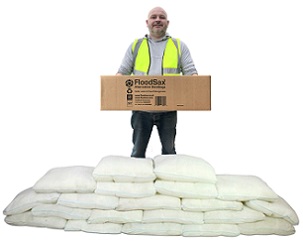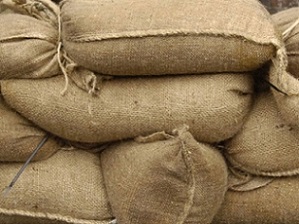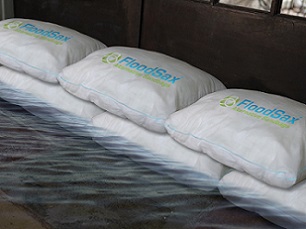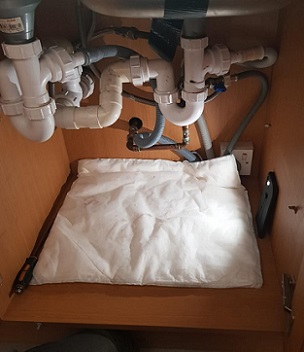 All these 20 FloodSax alternative sandbags came from this one easy-to-carry box
All these 20 FloodSax alternative sandbags came from this one easy-to-carry box
 Traditional sandbags don't tend to stack well
Traditional sandbags don't tend to stack well
 Now that's what we call a nice and neat anti-flood barrier using FloodSax sandless sandbags
Now that's what we call a nice and neat anti-flood barrier using FloodSax sandless sandbags
 FloodSax flood mitigation bags can be used indoors to soak up leaks and spills even when the plumbing looks like spaghetti junction
FloodSax flood mitigation bags can be used indoors to soak up leaks and spills even when the plumbing looks like spaghetti junction
10 reason why FloodSax alternative sandbags are far more environmentally friendly than sandbags
Every sandbag takes a heavy toll on the environment … but there is a simpler, greener and cleaner way to prevent floods.
People have never been more aware about the environment and many now look to protect it in any way they can.
This ranges from deliberately not using the earth’s precious natural resources to keeping use of vehicles to an absolute minimum.
When it comes to sandbags, FloodSax alternative sandbags tick all the right boxes while traditional sandbags, well, don’t.
Traditional sandbags use one of the earth’s natural resources – sand – and take up vast amounts of storage space in large warehouses that use up land and construction materials to build and masses of energy to light and heat. With energy costs now soaring the price can be astronomical and will continue to go up.
When deployed, sandbags need lorries to take them anywhere and then construct into barriers. The bigger the vehicle the more carbon monoxide, nitrogen oxide and hydrocarbons pollute the atmosphere, potentially damaging people’s health and triggering conditions such as asthma.
Sandbags are not biodegradable and need throwing away every time they’ve been used in a flood as floodwater is full of all kinds of nasty bugs and bacteria.
Here’s 10 reasons why FloodSax sandless sandbags are far better and greener than traditional sandbags
- FloodSax are vacuum-packed for neat, easy storage with one box of 20 that one person can easily carry equal to 20 sandbags on a pallet.
- The number of FloodSax that can be delivered by a pick-up truck is equal to more than 12,000lbs of sand – and you’ll need a rather large lorry for that.
- Transporting FloodSax flood mitigation bags has a very low carbon footprint compared to sandbags. The carbon dioxide levels (tCO2) to deliver 600 FloodSax is 0.0002 per km but far more at 0.0163 per km to deliver 600 sandbags. The average freight lorryemits 161.8 grams of CO2 perton-mile.
- FloodSax flood resilience bags are largely biodegradable and can be disposed of in landfill.
- FloodSax are transported in cardboard boxes which are totally recyclable and biodegradable.
- FloodSax flood control bags come in packs of 5 in a carrier bag which is made from a bio-based plastic manufactured from renewable biologicalresources.
- FloodSax are guaranteed for 5 years but if stored well will last indefinitely as they are vacuum-packed. Traditional sandbags take up lots of space to store and tend to deteriorate over time, especially if stored in damp warehouses where they are likely to fall apart when moved.
- Sandbags are only used to stop floodwater getting into homes and businesses but FloodSax are a highly effective and multi-use flood management product that can be used both indoors and outside. In their dry state they are ultra-thin and resemble large pillowcases so can be slipped under pipes, underneath sinks and beneath boilers to soak up drips, leaks, spills and floods, especially in hard-to-reach places. When deployed outside, once they are immersed in water the gelling polymer inside absorbs 20 litres so they inflate to resemble traditional sandbags but are more uniform and even so are easier to build into effective flood barriers.
- Councils have no responsibility to provide sandbags so people who have thought ahead and bought FloodSax have peace of mind that they can be quickly and easily deployed to stop a flood. Flooding is known as “the thief who takes everything.” This is because a typical insurance claim is 37 times more than the average claim for a burglary. Once people are flooded, everything has to be thrown away – carpets, furnishings, furniture, electrical items – which is a massive waste of resources and will need to be replaced by new items which are costly and may need natural resources to make.
- The Environment Agency estimates that 5.2 million homes and businesses in England are at risk of flooding and the average cost of flood damage to a home is £30,000. People can easily store FloodSax to save all that damage but would have no room for sandbags which are difficult to store and heavy to move. There are clear social benefits to having FloodSax as they can be deployed quickly by anybody, including the elderly and frail who would be totally unable to lift and move heavy sandbags.